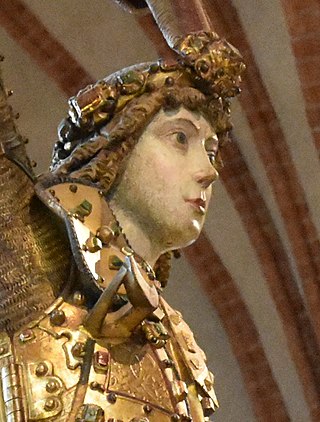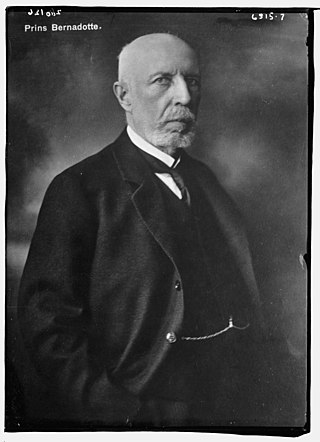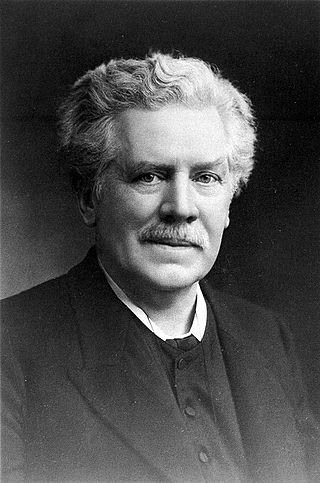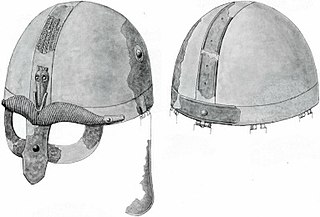
Gustaf V was King of Sweden from 8 December 1907 until his death in 1950. He was the eldest son of King Oscar II of Sweden and Sophia of Nassau, a half-sister of Adolphe, Grand Duke of Luxembourg. Reigning from the death of his father Oscar II in 1907 to his own death nearly 43 years later, he holds the record of being the oldest monarch of Sweden with the third-longest reign after Magnus IV (1319–1364) and his great-grandson, Carl XVI Gustaf (1973–present). He was also the last Swedish monarch to exercise his royal prerogatives, which largely died with him, although they were formally abolished only with the remaking of the Swedish constitution in 1974. He was the first Swedish king since the High Middle Ages not to have a coronation and so never wore the king's crown, a practice that has continued ever since.

Sten Sture the Elder was a Swedish statesman and regent of Sweden from 1470 to 1497 and again from 1501 to 1503. As the leader of the victorious Swedish separatist forces against the royal unionist forces during the Battle of Brunkeberg in 1471, he weakened the Kalmar Union considerably and became the effective ruler of Sweden as Lord Regent for most of his remaining life.

Sture was a name borne by three distinct but interrelated noble families in Sweden in the Late Middle Ages and Early Modern Period. It was originally a nickname, meaning 'haughty, proud', but later became a surname. Particularly famous are the three regents from these families who ruled Sweden in succession during the fifty-year period between 1470 and 1520, namely:

Prince Oscar Carl August Bernadotte, Count of Wisborg was a Swedish religious activist, the second son of King Oscar II of Sweden and his consort, Sofia of Nassau. Born as a Prince of Sweden and Norway, he was known as Prince Oscar, Duke of Gotland. However, by marrying contrary to Swedish constitutional requirements, he lost those titles, becoming instead Luxembourgish nobility as Prince Bernadotte and Count of Wisborg.

Prince Charles Philip of Sweden, Duke of Södermanland, (Swedish: Carl Filip; 22 April 1601 – 25 January 1622) was a Swedish prince, Duke of Södermanland, Närke and Värmland. Charles Philip was the second surviving son of King Charles IX of Sweden and his second spouse, Duchess Christina of Holstein-Gottorp.

Josephine of Leuchtenberg, also Josefina, was Queen of Sweden and Norway from 8 March 1844 to 8 July 1859 as the wife of King Oscar I. She was also Princess of Bologna from birth and Duchess of Galliera from 1813. She was regarded as politically active during the reign of her spouse and acted as his political adviser, actively participating in government affairs. She is acknowledged as having introduced more liberal laws regarding religion.

Prof Magnus GustafRetzius FRSFor HFRSE MSA was a Swedish physician and anatomist who dedicated a large part of his life to researching the histology of the sense organs and nervous system.

Emilie Sophie Högquist or Högqvist was a Swedish stage actress. She was a star of the Royal Dramatic Theatre and has been referred to as the first celebrity within Swedish drama and known as the Swedish Aspasia, both for her artistic ability but also for the literary salon she hosted. She is also known in history for her love affair with King Oscar I of Sweden.

Andrée's Arctic balloon expedition of 1897 was a failed Swedish effort to reach the North Pole, resulting in the deaths of all three expedition members, S. A. Andrée, Knut Frænkel, and Nils Strindberg. Andrée, the first Swedish balloonist, proposed a voyage by hydrogen balloon from Svalbard to either Russia or Canada, which was to pass, with luck, straight over the North Pole on the way. The scheme was received with patriotic enthusiasm in Sweden, a northern nation that had fallen behind in the race for the North Pole.

The Russo-Swedish War of 1495–1497, known in Sweden as the Stures' Russian War, in Russia First Swedish War, was a border war which occurred between the Grand Duchy of Moscow and the Kingdom of Sweden. Although the war was relatively short, and did not lead to any territorial changes, it has significance as the first war between Sweden and Moscow. Sweden earlier fought wars against the Novgorod Republic, before Novgorod was formally annexed to Moscow in 1478.

The Museum of Ethnography, in Stockholm, Sweden, is a Swedish science museum. It houses a collection of about 220,000 items relating to the ethnography, or cultural anthropology, of peoples from around the world, including from China, Korea, South and Southeast Asia, the Pacific region, the Americas and Africa. The museum is situated in Museiparken at Gärdet in Stockholm. Since 1999, it is a part of Swedish National Museums of World Culture and is also hosting the Sven Hedin Foundation. The museum is open Tuesday to Sunday 11:00AM – 5:00 PM, and Wednesdays 11:00 AM – 8:00 PM and is closed on Mondays.

Knut Hjalmar Stolpe, was a Swedish entomologist, archaeologist, and ethnographer. He was the first director and curator of the Museum of Ethnography, Sweden. He is best known for his meticulous archaeological excavations at the Viking-age site Birka on the island Björkö.
The Swedish Society for Anthropology and Geography is a scientific learned society founded in December 1877. It was established after a rearrangement of various sections of the Anthropological Society, which was formed in 1873 by Hjalmar Stolpe, Hans Hildebrand, Oscar Montelius, and Gustaf Retzius.

Gustaf VI Adolf was King of Sweden from 29 October 1950 until his death in 1973. He was the eldest son of Gustaf V and his wife, Victoria of Baden. Before Gustaf Adolf acceded to the throne, he was crown prince for nearly 43 years during his father's reign. As king, and shortly before his death, he gave his approval to constitutional changes which removed the Swedish monarchy's last political powers. He was a lifelong amateur archeologist particularly interested in Ancient Italian cultures.

Stegeborg Castle is a ruined castle in St Anna parish, Söderköping, Östergötland, located on an island in a narrow sound at the bay of Slätbaken, Sweden.

Salomon August Andrée, during his lifetime most often known as S. A. Andrée, was a Swedish engineer, physicist, aeronaut and polar explorer who died while leading an attempt to reach the Geographic North Pole by hydrogen balloon. The balloon expedition was unsuccessful in reaching the Pole and resulted in the deaths of all three of its participants.
Fernandoz is a Swedish dansband formed in 1986 in Vitsand, near Torsby. They had a big hit in 1991 entitled with the song "Jag vet att jag vill ha dig". The band won the "svenska dansbandsmästare" award in 1993 and they started appearing on the popular television program Bingolotto, for a number of times. Their most recognized hits include "Guld och gröna skogar", "En dag den sommaren", "När ett hjärta har älskat" Band guitarist Conny Ohlson and singer Anders Nordlund have won a Swedish Grammy "Guldklaven" for their work.

The VegaExpedition of 1878–1880, named after the SS Vega and under the leadership of Finland-Swedish explorer Adolf Erik Nordenskiöld, was the first Arctic expedition to navigate through the Northeast Passage, the sea route between Europe and Asia through the Arctic Ocean, and the first voyage to circumnavigate Eurasia. Initially a troubled enterprise, the successful expedition is considered to be among the highest achievements in the history of Swedish science.

The Broe helmet is a decorated iron helmet from around the Vendel Period. Discovered around 1904 in a cremation grave in Broe, a farm on the Swedish island Gotland, it was located alongside other items including fragments of shields, weapons, bridles, and game pieces. Due to its extremely fragmented condition, only an incomplete reconstruction of the helmet is possible, but it appears to have been an example of the "crested helmets" that flourished in England and Scandinavia from the sixth through eleventh centuries.

Admiral Henning Wilhelm Mauritz von Krusenstierna was a senior Swedish Navy officer. von Krusenstierna's served as head of the Military Office of the Ministry for Naval Affairs (1906–1909), as Flag Captain (1909–1915), as Minister for Naval Affairs (1910–1911) and as Chief of the Naval Staff (1916–1927).




















